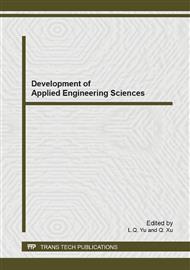[1]
F. Teng and Q. Liu, Multi-scale ship tracking via random projections, SIViP, 2014, pp.1-8; DOI 10. 1007/s11760-014-0629-4.
Google Scholar
[2]
F. Teng, et al., Real-time Ship Tracking via Enhanced MIL Tracker, Proc. 2013 Fifth International Conference on Emerging Trends in Engineering and Technology, IETET-2013, October 17th 2013-October 19th 2013, pp.399-404.
Google Scholar
[3]
Z. Kalal, et al., Face-TLD: Tracking-learning-detection applied to faces, Proc. 2010 17th IEEE International Conference on Image Processing, ICIP 2010, September 26, 2010 - September 29, 2010, IEEE Computer Society, 2010, pp.3789-3792.
DOI: 10.1109/icip.2010.5653525
Google Scholar
[4]
Z. Kalal, et al., P-N learning: Bootstrapping binary classifiers by structural constraints, Proc. 2010 IEEE Computer Society Conference on Computer Vision and Pattern Recognition, CVPR 2010, June 13, 2010 - June 18, 2010, IEEE Computer Society, 2010, pp.49-56.
DOI: 10.1109/cvpr.2010.5540231
Google Scholar
[5]
Z. Kalal, et al., Online learning of robust object detectors during unstable tracking, Proc. 2009 IEEE 12th International Conference on Computer Vision Workshops, ICCV Workshops 2009, September 27, 2009 - October 4, 2009, IEEE Computer Society, 2009, pp.1417-1424.
DOI: 10.1109/iccvw.2009.5457446
Google Scholar
[6]
D. Simon, Kalman filtering with state constraints: a survey of linear and nonlinear algorithms, IET Control Theory and Applications, vol. 4, no. 8, 2010, pp.1303-1318, DOI 10. 1049/iet-cta. 2009. 0032.
DOI: 10.1049/iet-cta.2009.0032
Google Scholar
[7]
F. Zhang, et al., Overview of nonlinear Bayesian filtering algorithm, Proc. 2011 International Conference on Advanced in Control Engineering and Information Science, CEIS 2011, August 18, 2011 - August 19, 2011, Elsevier Ltd, 2011, pp.489-495.
DOI: 10.1016/j.proeng.2011.08.093
Google Scholar
[8]
K. Zhang, et al., Real-time compressive tracking, Proc. 12th European Conference on Computer Vision, ECCV 2012, October 7, 2012 - October 13, 2012, Springer Verlag, 2012, pp.864-877.
DOI: 10.1007/978-3-642-33712-3_62
Google Scholar
[9]
Z. Kalal, et al., Tracking-Learning-Detection, IEEE Trans Pattern Anal Mach Intell, vol. 34, no. 7, 2011, pp.1409-1422; DOI 10. 1109/TPAMI. 2011. 239.
DOI: 10.1109/tpami.2011.239
Google Scholar
[10]
B. Babenko, et al., Visual tracking with online multiple instance learning, Proc. 2009 IEEE Computer Society Conference on Computer Vision and Pattern Recognition Workshops, CVPR Workshops 2009, June 20, 2009 - June 25, 2009, IEEE Computer Society, 2009, pp.983-990.
DOI: 10.1109/cvpr.2009.5206737
Google Scholar
[11]
Y. Wu, et al., Online object tracking: A benchmark, Proc. 26th IEEE Conference on Computer Vision and Pattern Recognition, CVPR 2013, June 23, 2013 - June 28, 2013, IEEE Computer Society, 2013, pp.2411-2418.
DOI: 10.1109/cvpr.2013.312
Google Scholar


